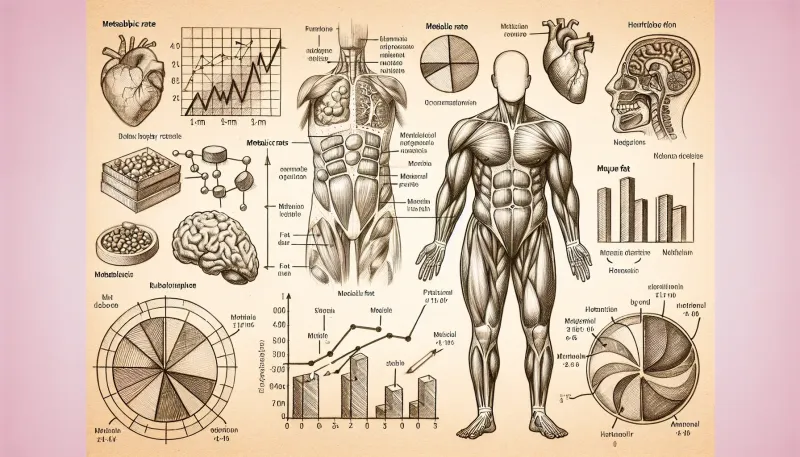Understanding Metabolic Rate and Body Composition: A Comprehensive Guide

Discover in-depth insights into metabolic rate and body composition. Learn how they impact your health and fitness goals with expert advice.
Maintaining optimal health and fitness requires a fundamental understanding of metabolic rate and body composition. These two elements play a critical role in how your body processes energy, builds muscle, and stores fat. In this comprehensive guide, we will delve into the intricacies of metabolic rate and body composition, providing valuable insights and practical advice to help you achieve your health goals.
What is Metabolic Rate?
Metabolic rate refers to the rate at which your body burns calories to sustain life. The metabolic rate is divided into two primary categories:
Basal Metabolic Rate (BMR)
Your BMR represents the number of calories your body needs at rest to maintain essential functions like breathing, circulation, and cell production. It accounts for approximately 60-75% of your total daily energy expenditure.
Active Metabolic Rate (AMR)
AMR includes the calories burned through all physical activities, from walking and exercising to digestion and even fidgeting. This parameter varies greatly depending on your lifestyle and level of physical activity.
Factors Influencing Metabolic Rate
Several factors affect your metabolic rate, including:
Age
As you age, your metabolic rate typically slows down, making it easier to gain weight.
Gender
Generally, men have a higher metabolic rate compared to women due to having more muscle mass.
Body Composition
Individuals with more muscle mass have a higher metabolic rate since muscle tissue burns more calories than fat.
Genetics
Genetic makeup can influence your metabolic rate, affecting how efficiently your body utilizes calories.
Hormone Levels
Hormones such as thyroid hormones and insulin can significantly impact metabolic rate.
Diet and Nutrition
The type of nutrients you consume can affect your metabolic rate. For instance, protein requires more energy to digest than fats or carbohydrates, thereby increasing BMR.
Understanding Body Composition
Body composition refers to the relative percentage of fat mass and fat-free mass (muscles, bones, water, etc.) in your body. It provides a more comprehensive understanding of your health and fitness compared to just looking at weight or Body Mass Index (BMI).
Components of Body Composition
- Fat Mass: This includes essential fat (necessary for normal physiological function) and storage fat (accumulated fat deposits).
- Fat-Free Mass: This encompasses muscles, bones, organs, and body water.
Measuring Body Composition
Several techniques are available to measure body composition, each with varying degrees of accuracy:
Bioelectrical Impedance Analysis (BIA)
BIA devices measure body composition by sending a small, safe electrical current through the body. Resistance to the current flows differently in fat and muscle tissues, allowing the device to estimate body composition.
Dual-Energy X-Ray Absorptiometry (DEXA)
DEXA scans use low-level X-rays to differentiate between bone mass, fat tissue, and lean body mass, providing one of the most accurate body composition measurements.
Skinfold Calipers
This method involves pinching and measuring folds of skin at specific body sites to estimate body fat percentage.
Hydrostatic Weighing
Also known as underwater weighing, this technique measures body density by underwater body weight, providing accurate estimates of body composition.
Why Understanding Metabolic Rate and Body Composition Matters
Having a grasp of metabolic rate and body composition is crucial for several reasons:
Weight Management
Understanding how your metabolic rate influences calorie needs can help structure effective weight management plans, whether your goal is to lose, gain, or maintain weight.
Improving Athletic Performance
Athletes can benefit from knowing their body composition to develop training programs that enhance muscle mass and reduce fat, thereby improving performance.
Health Monitoring
Regularly monitoring body composition helps in assessing health risks associated with high fat or low muscle mass, such as cardiovascular diseases, diabetes, and osteoporosis.
Practical Tips for Optimizing Metabolic Rate and Body Composition
Here are some actionable strategies to optimize your metabolic rate and improve your body composition:
Engage in Regular Exercise
Incorporate both aerobic exercises (like running or cycling) and strength training (like weightlifting) into your routine to boost muscle mass and metabolic rate.
Eat a Balanced Diet
Focus on consuming a balanced diet rich in whole foods, lean proteins, healthy fats, and complex carbohydrates to support metabolic health and muscle building.
Stay Hydrated
Adequate water intake is essential for metabolic processes and can aid in weight management.
Get Enough Sleep
Quality sleep is critical for hormone regulation and metabolic function. Aim for 7-9 hours of sleep per night.
Manage Stress
Chronic stress can negatively impact hormone levels and metabolic rate. Practice stress-relief techniques such as meditation, yoga, or deep breathing exercises.
Conclusion
Understanding metabolic rate and body composition is essential for anyone looking to improve their health, manage weight, or enhance athletic performance. By considering the factors influencing metabolic rate and accurately assessing body composition, you can make informed decisions to optimize your fitness and overall well-being. Implementing the practical tips provided in this guide will help you on your journey to a healthier and more balanced life.



























